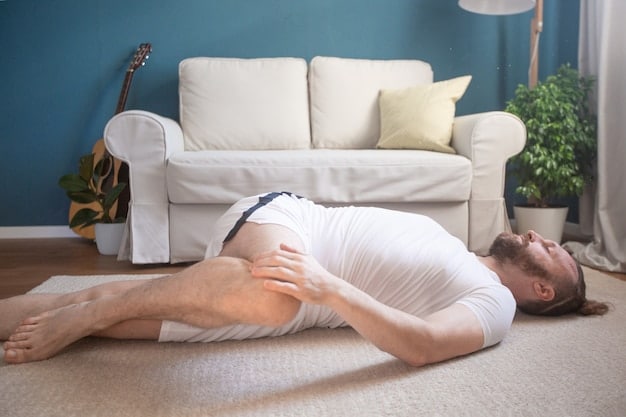Mindful Breathing: 5 Easy Exercises for Stress Relief & Focus

Mindful breathing exercises are powerful techniques to reduce stress and boost focus, integrating simple yet effective methods into your daily routine, which can significantly improve your mental and emotional well-being in just five minutes.
Feeling overwhelmed? Discover how mindful breathing exercises can be your secret weapon against stress and lack of focus. These 5 techniques, requiring only 5 minutes of your time, can transform your day.
The Science of Mindful Breathing
Mindful breathing is more than just taking a deep breath; it’s about bringing awareness to the present moment and observing your breath without judgment. This simple act can have profound effects on your nervous system, helping to reduce stress hormones and promote relaxation.
The connection between breath and well-being has been recognized for centuries in various meditative traditions. Modern science is now catching up, providing empirical evidence of the numerous benefits of mindful breathing.
How Breathing Impacts Stress
When you’re stressed, your body enters “fight or flight” mode. Your heart rate increases, your breathing becomes shallow and rapid, and stress hormones like cortisol are released. Mindful breathing helps to reverse this process.
- Activates the Parasympathetic Nervous System: Slow, deep breathing stimulates the vagus nerve, which is a major component of the parasympathetic nervous system, responsible for the “rest and digest” response.
- Reduces Cortisol Levels: Regular mindful breathing practice can lower cortisol levels, reducing feelings of anxiety and stress.
- Improves Heart Rate Variability: HRV, a measure of the variation in time intervals between heartbeats, is an indicator of your body’s resilience to stress. Mindful breathing can improve HRV.
By consciously controlling your breath, you can send signals to your brain that you are safe and calm, which promotes relaxation and reduces stress.
In conclusion, mindful breathing provides a direct pathway to calming the nervous system and reducing the physiological effects of stress. This makes it a valuable tool for managing daily anxieties and promoting overall well-being.
Diaphragmatic Breathing (Belly Breathing)
Diaphragmatic breathing, also known as belly breathing, is a technique that encourages full, deep breaths using the diaphragm muscle. This is a more efficient way of breathing that can help you feel relaxed and grounded.
Many people breathe shallowly from their chest, which can exacerbate feelings of anxiety. Belly breathing helps to reverse this pattern by engaging the diaphragm, allowing for fuller lung expansion and better oxygen exchange.

How to Practice Belly Breathing
Find a quiet place where you can lie down or sit comfortably. Place one hand on your chest and the other on your abdomen. This will help you feel the movement of your breath.
- Inhale Slowly: Breathe in slowly through your nose, allowing your abdomen to rise as you fill your lungs with air. Your chest should remain relatively still.
- Exhale Slowly: Breathe out slowly through your mouth, allowing your abdomen to fall. Gently contract your abdominal muscles to fully expel the air.
- Repeat: Continue this process for 5-10 minutes, focusing on the rise and fall of your abdomen.
Belly breathing promotes relaxation by activating the parasympathetic nervous system and improving oxygen flow throughout the body.
In summary, diaphragmatic breathing is a simple yet powerful technique that can help you reduce stress and improve relaxation by engaging the diaphragm and promoting fuller, deeper breaths.
Box Breathing (Square Breathing)
Box breathing, also known as square breathing, is a technique used by Navy SEALs and others in high-stress situations to regain focus and control. It involves inhaling, holding, exhaling, and holding again, each for the same amount of time.
This structured breathing pattern helps to regulate the nervous system and clear the mind, making it easier to think clearly and make rational decisions under pressure.
Steps for Effective Box Breathing
Find a comfortable position, either sitting or lying down. Close your eyes if that helps you focus. Visualize a box or square in your mind as you go through each step.
- Inhale: Slowly inhale through your nose for a count of four.
- Hold: Hold your breath for a count of four.
- Exhale: Slowly exhale through your mouth for a count of four.
- Hold: Hold your breath again for a count of four.
Repeat this cycle for 5-10 minutes, maintaining a steady rhythm and focus. With consistent practice, box breathing can become a valuable tool for managing stress and improving focus.
To conclude, box breathing is a structured technique that helps to regulate the nervous system and improve focus by following a consistent pattern of inhalation, holding, exhalation, and holding.
Alternate Nostril Breathing (Nadi Shodhana)
Alternate nostril breathing, known as Nadi Shodhana in Sanskrit, is a yogic breathing technique that balances the left and right hemispheres of the brain. This can lead to a sense of calm and mental clarity.
In yogic philosophy, the left nostril is associated with the lunar energy, which is cooling and calming, while the right nostril is associated with the solar energy, which is energizing and heating. Balancing these energies can promote overall well-being.
How to Practice Nadi Shodhana
Sit comfortably with a straight spine. Use your right hand to close off your nostrils. The thumb closes the right nostril, and the ring finger closes the left nostril.
- Close Right Nostril: Close your right nostril with your thumb and inhale slowly through your left nostril.
- Close Left Nostril, Open Right: Release your thumb and close your left nostril with your ring finger. Exhale slowly through your right nostril.
- Inhale Right Nostril: Inhale slowly through your right nostril.
- Close Right Nostril, Open Left: Close your right nostril with your thumb and exhale slowly through your left nostril.
Continue this cycle for 5-10 minutes, maintaining a gentle and steady rhythm. Focus on the flow of your breath and the sensations in your nostrils.
In essence, alternate nostril breathing is a balancing practice that can promote calm and mental clarity by harmonizing the energies associated with the left and right hemispheres of the brain.
Lion’s Breath (Simhasana Pranayama)
Lion’s breath, or Simhasana Pranayama, is a more active and expressive breathing technique that helps to release tension in the face, jaw, and chest. It’s a fun and energizing way to relieve stress.
This technique involves a strong exhalation through the mouth while sticking out your tongue and roaring like a lion. It can help to release pent-up emotions and promote self-expression.

How to Perform Lion’s Breath
Sit comfortably on your heels or in a chair. Spread your knees wide and place your hands on your knees with your fingers spread wide like a lion’s paws.
- Inhale Deeply: Take a deep breath in through your nose.
- Exhale Forcefully: Open your mouth wide, stick out your tongue towards your chin, and exhale forcefully with a “ha” sound, like a lion roaring.
- Gaze Upward: Gaze upwards towards your third eye point (the space between your eyebrows).
Repeat this 5-7 times. Notice the release of tension in your face, jaw, and chest. You may feel a sense of exhilaration and lightness.
In conclusion, lion’s breath is an expressive technique that can help to release tension and promote self-expression by combining a deep inhalation with a forceful exhalation and a lion-like roar.
4-7-8 Breathing Technique
The 4-7-8 breathing technique, developed by Dr. Andrew Weil, promotes relaxation and reduces anxiety by regulating the breath. It’s an effective method for calming the mind and preparing for sleep. This technique involves inhaling for four seconds, holding the breath for seven seconds, and exhaling for eight seconds.
The 4-7-8 breathing technique is designed to reduce anxiety and promote relaxation by regulating the autonomic nervous system’s response to stress. Regular practice can lead to improved mental and physical health.
Steps to Practice the 4-7-8 Technique
To perform the 4-7-8 breathing technique, find a quiet place where you can sit or lie down comfortably. Ensure that you can maintain focus and minimize distractions. Once settled, follow these steps:
- Exhale Completely: Before starting, exhale completely through your mouth, emptying your lungs of air.
- Inhale Quietly: Close your mouth and inhale quietly through your nose for a count of four.
- Hold Your Breath: Hold your breath for a count of seven seconds.
- Exhale Slowly: Exhale completely through your mouth for a count of eight seconds, making a whooshing sound.
Repeat this cycle four times initially, gradually increasing repetitions as you become more comfortable. Focus on maintaining consistent counts and complete exhalations to maximize effectiveness.
In summary, the 4-7-8 breathing technique offers a structured approach to quieting the mind and easing tension through the rhythmic control of inhalation, breath retention, and exhalation.
| Key Point | Brief Description |
|---|---|
| 🧘♂️ Diaphragmatic Breathing | Deep breaths using the diaphragm for relaxation. |
| 🧮 Box Breathing | Structured breathing to regulate nervous system. |
| 👃 Alternate Nostril Breathing | Balances brain hemispheres for mental clarity. |
| 🦁 Lion’s Breath | Releases tension in face and chest with a roar. |
Frequently Asked Questions
Mindful breathing is a practice that involves focusing on your breath to anchor yourself in the present moment. It’s about paying attention to the sensations of breathing without judgment.
Ideally, practice daily for 5-10 minutes. Consistency is key to experiencing the full benefits, but even a few minutes can make a difference in moments of high stress.
Yes, many of these techniques, particularly diaphragmatic breathing and the 4-7-8 method, can calm the mind and relax the body, making it easier to fall asleep.
Generally, mindful breathing is safe. However, if you have a respiratory condition or anxiety disorder, it’s best to consult with a healthcare professional before starting.
Some people experience immediate relief from stress and improved focus, while others may notice benefits after a few weeks of consistent practice. Results vary.
Conclusion
Incorporating mindful breathing exercises into your daily routine can be a transformative step toward reducing stress and enhancing focus. These simple techniques offer a readily accessible path to improved mental and emotional well-being, requiring just a few minutes each day to cultivate a sense of calm and clarity that can positively impact all aspects of your life.





